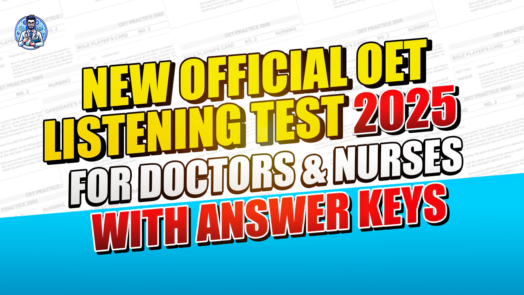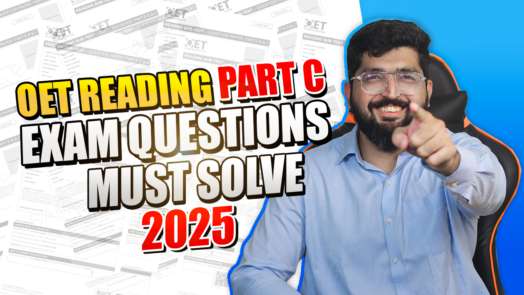
The initial subtest you’ll face in your OET exam is the OET Listening subtest. This OET Listening subtest is straightforward to excel in, yet some exceptional students fail to pass due to minor errors. In this guideline by Dr. Nasir, you’ll learn how to ace your OET Listening subtest effectively.
Understanding the OET Listening Subtest
First and foremost, having a proper study plan is crucial for clearing the OET Listening subtest, which is divided into three parts:
- Part A: 24 marks
- Part B: 6 marks
- Part C: 12 marks
OET Listening Part A
OET Listening Part A is quite simple to clear and is significant for passing the OET Listening exam. Scoring 23 in OET Listening Part A is quite manageable with the right approach. Here are the best pro tips for mastering this section:
- Predict Answers: When you get 30 seconds to read the text in OET Listening Part A, focus only on the sections with blanks and try to predict the type of answer needed, such as a timeframe, symptom, disease, diagnosis, test, or treatment plan. This strategy will help you score higher.
- Stay Ahead: Always stay ahead of the audio. As the audio plays, ensure you’ve read the text extract ahead of it. This allows you to write your answer and move to the next blank without re-reading the text, as you’ll already be familiar with it.
- Use Abbreviations Correctly: It’s crucial to write abbreviations in capital letters, not lowercase, as writing them in lowercase can result in lost marks.
- Maintain Focus: Maintaining focus, especially after question 16 in the second extract, is essential. Many students lose concentration at this point. Enhance your focus through meditation and avoid distractions.
- Stay Calm: If the audio presents a segment with a lot of information but no relevant answer, remain calm and wait. Your answer will come; avoid panicking.
- Be Energized: Ensure you’re well-rested and have a good breakfast before the exam. Consuming coffee or an energy drink like Red Bull can help keep you energized, as the exam can be mentally exhausting.
- Practice and Review: Practice makes perfect. If you score 18/24 in OET Listening Part A during practice and don’t review the audio to identify and correct your mistakes, your chances of passing the OET Listening exam may decrease significantly. Always revisit the audio to understand your errors and improve.
By applying these tips, you’ll significantly increase your chances of acing the OET Listening exam.
OET Listening Part B
To excel in Part B, which involves listening to short extracts from a healthcare workplace, consider the following strategies:
- Understand the Format: Part B consists of six short recordings, each with a multiple-choice question. Familiarity with the format is key.
- Practice Active Listening: Engage with English audio in various accents, especially those related to healthcare, through podcasts, news reports, and videos.
- Enhance Your Vocabulary: Expand your knowledge of medical terminology and common healthcare phrases.
- Develop Note-Taking Skills: Practice jotting down key details while listening, which can be crucial for answering questions correctly.
- Read Questions Carefully: Know what to listen for by understanding the questions before the recording starts.
- Identify Keywords: Recognize keywords in both the questions and options to guide you to the correct answer.
- Use Timed Practice Tests: Improve your time management and learn to allocate your time effectively.
- Listen for Paraphrasing: The correct answer may paraphrase information from the recording. Be ready to identify synonyms and similar expressions.
- Improve Prediction Skills: Anticipate the content of the listening piece based on the question to prepare mentally.
- Review Mistakes: Always analyze your errors after practicing to learn from them.
OET Listening Part C
Although Part C is perceived as challenging, it’s manageable with the right strategies:
- Read Questions Carefully: Prioritize reading the questions carefully during the 90 seconds before the audio starts. Understanding the questions is crucial.
- Identify Keywords: Distinguish between constant keywords (present in both the question and audio) and synonymous keywords (helping to identify the answer based on option similarities).
- Move On if Stuck: If you can’t find an answer, move on. The audio won’t pause, and dwelling on a single question might cost you the opportunity to answer easier subsequent questions.
By adopting these targeted strategies, you can navigate each part of the OET Listening subtest with confidence and increase your chances of success.
 drnasiracademy
drnasiracademy 


